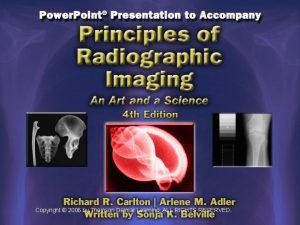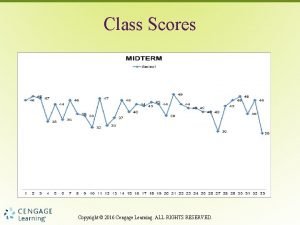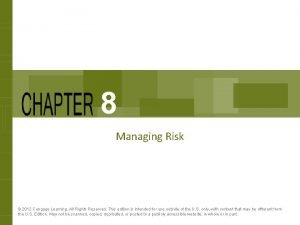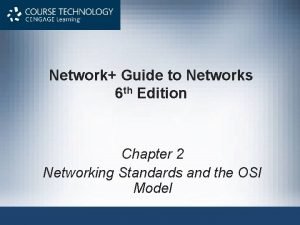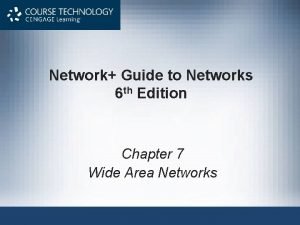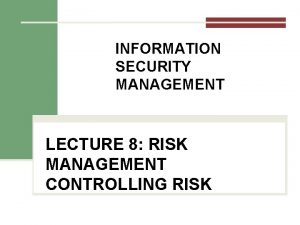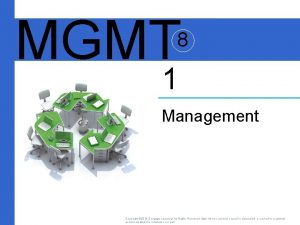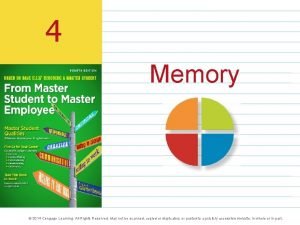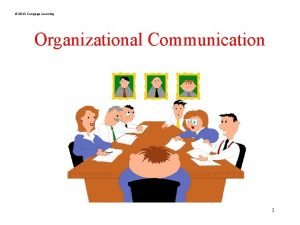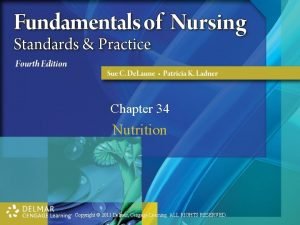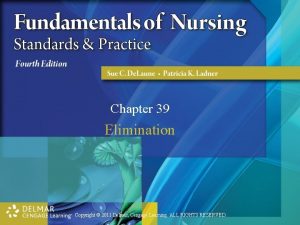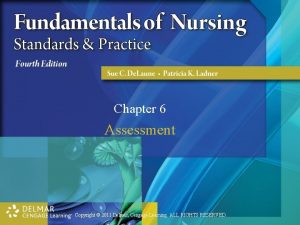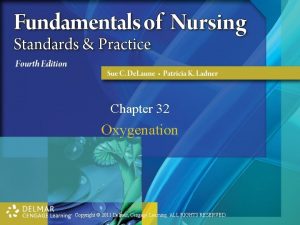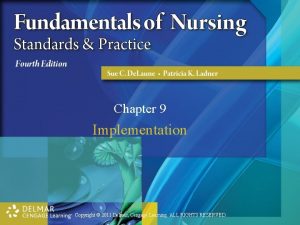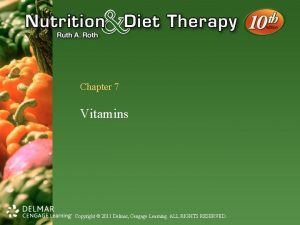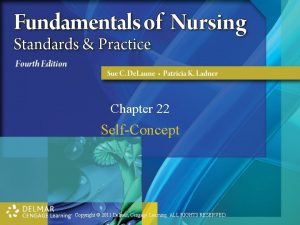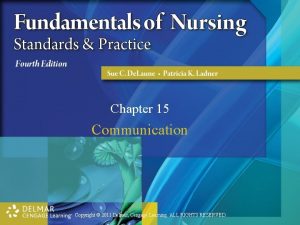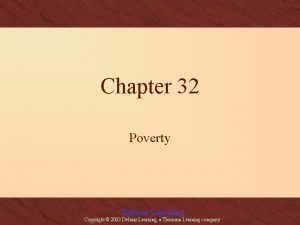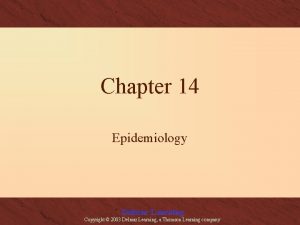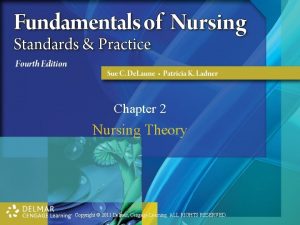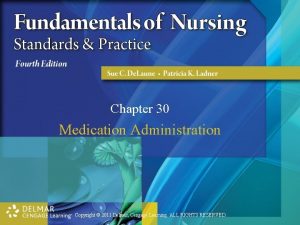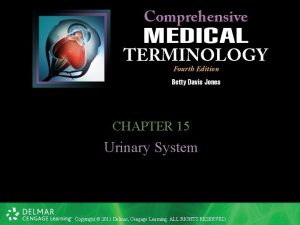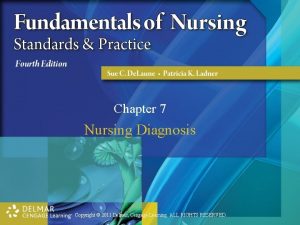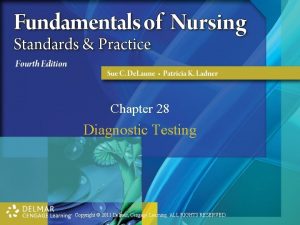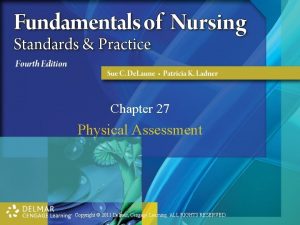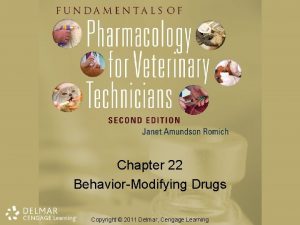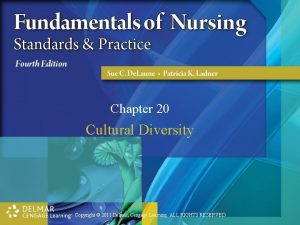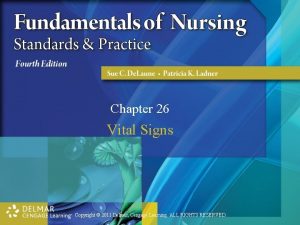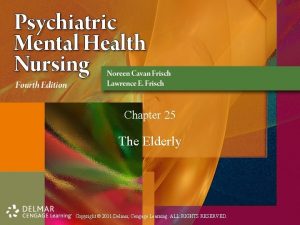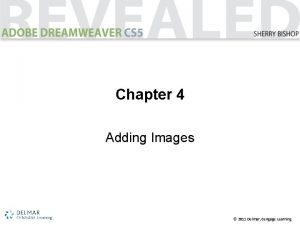Chapter 9 Water Copyright 2011 Delmar Cengage Learning







































- Slides: 39

Chapter 9 Water Copyright © 2011 Delmar, Cengage Learning. ALL RIGHTS RESERVED.

Objectives • Describe functions of water in body • Explain fluid balance and its maintenance • Name causes and consequences of water depletion • Give some causes and consequences of positive fluid balance • Describe acid-base balance in human body Copyright © 2011 Delmar, Cengage Learning. ALL RIGHTS RESERVED.

Facts • Humans can live approximately 30 to 45 days without food but only 10 to 14 days without water • Present in all body cells • 50 to 60 percent of body weight of normal adults – Percentage highest in newborns and decreases with age Copyright © 2011 Delmar, Cengage Learning. ALL RIGHTS RESERVED. (continues)

Facts • Two basic compartments: – Intracellular fluid (ICF) • Within cells • 65 percent of total body fluid – Extracellular fluid (ECF) • Outside cells • 35 percent of total body fluid • Found in intravascular fluid (in bloodstream), interstitial fluid (between cells), and glandular secretions Copyright © 2011 Delmar, Cengage Learning. ALL RIGHTS RESERVED.

Functions • Major component of blood plasma • Solvent and transport for nutrients and waste products • Essential component for hydrolysis and metabolism Copyright © 2011 Delmar, Cengage Learning. ALL RIGHTS RESERVED. (continues)

Functions • Lubricant in joints and digestion • Body coolant through perspiration • Shock absorber Copyright © 2011 Delmar, Cengage Learning. ALL RIGHTS RESERVED.

Sources • Best: – Drinking water • Second-best: – Other beverages • Other: – Fruits, vegetables, soups, milk, and gelatin desserts • Energy metabolism produces water Copyright © 2011 Delmar, Cengage Learning. ALL RIGHTS RESERVED.

Estimated Daily Fluid Intake for an Adult • Ingested liquids: – 1, 500 m. L • Water in foods: – 700 m. L • Water from oxidation: – 200 m. L • Total = 2, 400 m. L Copyright © 2011 Delmar, Cengage Learning. ALL RIGHTS RESERVED.

Fluid and Electrolyte Balance • Electrolytes measured in milliequivalents (m. Eq/L) • Water losses must be replaced in volume and electrolyte content • Sensible water loss – Noticeable – Water lost through urine Copyright © 2011 Delmar, Cengage Learning. ALL RIGHTS RESERVED. (continues)

Fluid and Electrolyte Balance • Insensible water loss – Unnoticeable – Water lost through feces, perspiration, and respiration • Solute – Substance dissolved in solution • Osmosis – Water flows from side with lesser amount of solute to side with greater solute concentration Copyright © 2011 Delmar, Cengage Learning. ALL RIGHTS RESERVED. (continues)

Fluid and Electrolyte Balance • Potassium, sodium, and chloride maintain balance between ICFs and ECFs • Potassium – Principal electrolyte in ICF • Sodium – Principal electrolyte in ECF Copyright © 2011 Delmar, Cengage Learning. ALL RIGHTS RESERVED. (continues)

Fluid and Electrolyte Balance • Osmolality – Measures particles in solution • When electrolytes in ECF increase, ICF moves to ECF to equalize concentration of electrolytes on both sides of membrane – Reduces amount of water in cells Copyright © 2011 Delmar, Cengage Learning. ALL RIGHTS RESERVED. (continues)

Fluid and Electrolyte Balance • Hypothalamus stimulates pituitary gland to excrete antidiuretic hormone (ADH) • ADH causes kidneys to reabsorb water • Thirst causes healthy person to drink fluids • When sodium in ECF reduced, water flows from ECF into cells – Causes cellular edema Copyright © 2011 Delmar, Cengage Learning. ALL RIGHTS RESERVED. (continues)

Fluid and Electrolyte Balance • Adrenal glands secrete aldosterone – Triggers kidneys to increase amount of sodium reabsorbed • When sodium replaced in ECF, excess water moves back to ECF – Relieves edema Copyright © 2011 Delmar, Cengage Learning. ALL RIGHTS RESERVED. (continues)

Fluid and Electrolyte Balance • Amount of water use varies – Depends on age, size, activity, environmental temperature, and physical condition • Average adult requirement: – 1 milliliter (m. L) for every calorie of food consumed Copyright © 2011 Delmar, Cengage Learning. ALL RIGHTS RESERVED.

Stop and Share • Consider the following question: – How many glasses of fluid would be required for an adult eating 1, 800 kilocalories per day? Copyright © 2011 Delmar, Cengage Learning. ALL RIGHTS RESERVED. (continues)

Stop and Share • 1 m. L × 1, 800 calories = 1, 800 cubic centimeters (cc) • 1, 800 cc 240 ounces (oz) = 7. 5 glasses of water • Recommended for adults to drink eight 8 -oz glasses of fluid per day Copyright © 2011 Delmar, Cengage Learning. ALL RIGHTS RESERVED. (continues)

Stop and Share • Increased requirements during youth, fever, diarrhea, unusual perspiration, and hyperthyroidism Copyright © 2011 Delmar, Cengage Learning. ALL RIGHTS RESERVED.

Dehydration • Occurs when amount of water in body inadequate • Caused by inadequate intake or abnormal loss – Loss can occur from severe diarrhea, vomiting, hemorrhage, burns, diabetes mellitus, excessive perspiration, excessive urination, or use of certain medications (e. g. , diuretics) Copyright © 2011 Delmar, Cengage Learning. ALL RIGHTS RESERVED. (continues)

Dehydration • Symptoms: – Low blood pressure, thirst, dry skin, fever, and mental disorientation • As water lost, electrolytes also lost • Treatment: – Replacement of electrolytes and fluids Copyright © 2011 Delmar, Cengage Learning. ALL RIGHTS RESERVED. (continues)

Dehydration • 10 percent loss of body water can cause serious problems • 20 percent loss of body water can cause circulatory failure and death • Blood volume and nutrient absorption reduced Copyright © 2011 Delmar, Cengage Learning. ALL RIGHTS RESERVED. (continues)

Dehydration • Kidney function upset • Infants at high risk for dehydration during fever, vomiting, and diarrhea • Treatment may involve intravenous (IV) fluids Copyright © 2011 Delmar, Cengage Learning. ALL RIGHTS RESERVED. (continues)

Dehydration • Thirst sensation lags behind body’s need for water – Especially in elderly, children, athletes, and ill – Feeling thirsty not reliable indicator of when body needs water • Prevention: – Drink fluids throughout day Copyright © 2011 Delmar, Cengage Learning. ALL RIGHTS RESERVED. (continues)

Dehydration • Failure to replace water lost through perspiration could lead to one of four stages of heat illness: 1. 2. 3. 4. Heat fatigue Heat cramp Heat exhaustion Heat stroke Copyright © 2011 Delmar, Cengage Learning. ALL RIGHTS RESERVED.

Signs of Dehydration • Health history reveals inadequate intake of fluids • Decrease in urine output • Weight loss • Sunken eyes Copyright © 2011 Delmar, Cengage Learning. ALL RIGHTS RESERVED. (continues)

Signs of Dehydration • • Increased furrows and fissures on tongue Dry oral mucous membranes Decreased skin turgor Changes in neurological status Copyright © 2011 Delmar, Cengage Learning. ALL RIGHTS RESERVED.

Excess Water Accumulation • Positive water balance – More water taken in than excreted • Results in edema • May be caused by hypothyroidism, congestive heart failure, hypoproteinemia, some infections, some cancers, and some renal conditions • Fluids and sodium may be restricted Copyright © 2011 Delmar, Cengage Learning. ALL RIGHTS RESERVED.

Acid-Base Balance • • • Regulation of hydrogen ions Acid gives off hydrogen ions Base picks up hydrogen ions Acidic substances have p. H of 1 to 7 Alkaline substances have p. H of 7 to 14 p. H of 7 considered neutral Copyright © 2011 Delmar, Cengage Learning. ALL RIGHTS RESERVED. (continues)

Acid-Base Balance • • Blood plasma has p. H of 7. 35 to 7. 45 Intracellular fluid has p. H of 6. 8 Kidneys maintain acid-base balance What person eats affects acidity of urine – Not of body Copyright © 2011 Delmar, Cengage Learning. ALL RIGHTS RESERVED.

Buffer Systems • Regulate hydrogen ion content in body fluids • Mixture of weak acid and strong base • Normal buffer system ratio of base to acid: – 20: 1 • Carbonic acid and sodium bicarbonate form body’s main buffer system Copyright © 2011 Delmar, Cengage Learning. ALL RIGHTS RESERVED. (continues)

Buffer Systems • Carbonic acid moves easily to buffer strong alkali • Sodium bicarbonate moves easily to buffer strong acid • Amounts easily adjusted by lungs and kidneys to suit body’s needs Copyright © 2011 Delmar, Cengage Learning. ALL RIGHTS RESERVED. (continues)

Buffer Systems • End products of metabolism: – Carbon dioxide and water • Together, can form carbonic acid • Medulla oblongata in brain causes breathing rate to increase if amount of carbon dioxide more concentrated than should be – Increases rate at which body rids itself of carbon dioxide Copyright © 2011 Delmar, Cengage Learning. ALL RIGHTS RESERVED. (continues)

Buffer Systems • Excess sodium bicarbonate excreted via kidneys • Kidneys can excrete urine from p. H of 4. 5 to 8 • p. H of average urine: – 6 Copyright © 2011 Delmar, Cengage Learning. ALL RIGHTS RESERVED.

Acidosis and Alkalosis • Acidosis can be caused by renal failure, uncontrolled diabetes mellitus, starvation, or severe diarrhea • Alkalosis can occur when body has suffered loss of hydrochloric acid from severe vomiting or has ingested too much alkali (e. g. , too many antacid tablets) Copyright © 2011 Delmar, Cengage Learning. ALL RIGHTS RESERVED.

Stop and Share • Consider the following scenario: – A client is unhappy with her low-sodium, fluid-restricted diet. How can you best help her? Copyright © 2011 Delmar, Cengage Learning. ALL RIGHTS RESERVED. (continues)

Stop and Share • Discuss realistic ways of planning menus – Base menus on good nutrition and her normal habits and desires • Review her former diet with her – Point out high-salt and high-liquid foods – Present alternative foods in positive manner Copyright © 2011 Delmar, Cengage Learning. ALL RIGHTS RESERVED.

Conclusion • Water – Component of all tissues – Solvent for nutrients and body wastes • Provides transport for both • Essential for the following: – Hydrolysis – Lubrication – Maintenance of normal temperature Copyright © 2011 Delmar, Cengage Learning. ALL RIGHTS RESERVED. (continues)

Conclusion • Best sources: – Water, beverages, fruits, vegetables, soups, and waterbased desserts • Dehydration can result from lack of water • Positive water balance – Excess accumulation of water in body Copyright © 2011 Delmar, Cengage Learning. ALL RIGHTS RESERVED. (continues)

Conclusion • Acid-base balance – Regulation of hydrogen ions in body • Healthy people have intricate maintenance systems for fluid, electrolytes, and acid-base balance Copyright © 2011 Delmar, Cengage Learning. ALL RIGHTS RESERVED.
 Delmar cengage learning medical terminology
Delmar cengage learning medical terminology 2009 delmar cengage learning
2009 delmar cengage learning Chapter 1 matching medical terminology
Chapter 1 matching medical terminology Measuring and recording apical pulse
Measuring and recording apical pulse Chapter 6 skeletal system
Chapter 6 skeletal system 2009 delmar cengage learning
2009 delmar cengage learning 2009 delmar cengage learning
2009 delmar cengage learning Delmar cengage learning instructor resources
Delmar cengage learning instructor resources Copyright cengage learning. powered by cognero
Copyright cengage learning. powered by cognero Water and water and water water
Water and water and water water Thomson delmar learning
Thomson delmar learning Chapter 7:10 respitory system
Chapter 7:10 respitory system Cengage learning heart diagram
Cengage learning heart diagram Cengage learning heart diagram
Cengage learning heart diagram South-western cengage learning
South-western cengage learning Cengage learning heart diagram
Cengage learning heart diagram Cengage learning australia
Cengage learning australia Whille
Whille Cengage learning
Cengage learning Wadsworth cengage learning
Wadsworth cengage learning Cengage learning
Cengage learning Cengage learning plant cell
Cengage learning plant cell Cengage learning
Cengage learning Cengage learning
Cengage learning Brooks cole cengage learning
Brooks cole cengage learning 2014 cengage learning accounting answers
2014 cengage learning accounting answers Cengage learning
Cengage learning Cengage learning
Cengage learning Cengage learning
Cengage learning Cengage learning
Cengage learning 2012 cengage learning
2012 cengage learning Training evaluation
Training evaluation Cengage learning psychology
Cengage learning psychology Course technology cengage learning
Course technology cengage learning Course technology cengage learning
Course technology cengage learning Course technology cengage learning
Course technology cengage learning Course technology cengage learning
Course technology cengage learning Mgmt+8
Mgmt+8 2014 cengage learning
2014 cengage learning 2010 cengage learning
2010 cengage learning










